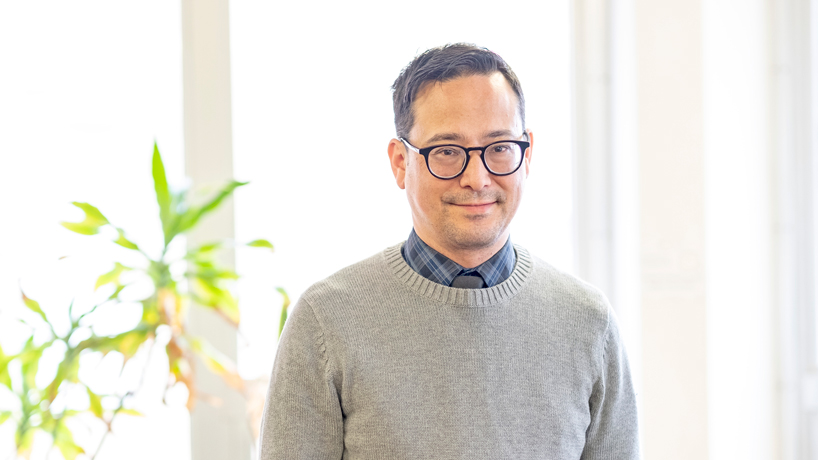
UMSL School of Social Work Assistant Professor Florian Sichling is in the middle of two studies, interviewing Bosnian refugees in St. Louis and Syrian refugees in St. Louis and Nuremberg, Germany. He’s trying to learn how their experiences have been shaped by their new countries. He hopes to discover how policymakers and community leaders can use this information to help the transition of urban immigrant communities. (Photo by August Jennewein)
As an academic, University of Missouri–St. Louis Assistant Professor of Social Work Florian Sichling realizes that a large part of his profession involves researching and publishing.
As a social worker, Sichling also recognizes the importance of keeping one key question at the forefront of his mind during the course of his work: So what?
“That’s what brings the research to life and moves it out of the ivory tower and into the community,” Sichling said. “We tend to write for the three people who read our stuff. It’s still important, but I also want it to matter for people in the field. The most rewarding feedback I get is when I talk to social workers in the field about my project and they say it’s the kind of stuff they see all the time, but they don’t really have the time to think about. That’s how I see my role.”
To that end, Sichling is in the middle of two studies of refugee adolescents that he hopes can help inform policymakers on best practices in integrating large immigrant communities into the lives of cities. The studies focus on Syrian male refugees aged 15-19 in St. Louis and Nuremberg, Germany, and on second-generation Bosnian youth aged 14-20 in St. Louis – the children of the wave of Bosnian immigrants that arrived in the city in the 1990s after escaping persecution in their home country because of their Muslim faith.
Sichling says that cities around the United States are looking toward immigrant communities to replenish workforces that have decentralized, and the experiences of Bosnian and Syrian refugees in St. Louis can serve as potent examples of what is successful when it comes to assimilating new populations and giving them chances for upward mobility.
“I have a very soft spot for places like St. Louis that are not very sexy in some ways, not very polished but that are actually much more representative for the urban experience in America than places like Chicago, L.A. or New York,” Sichling said. “We know much less about places like Cleveland, St. Louis or Pittsburgh, places that are struggling with decades of population loss and decline of manufacturing industries. There are certain institutional infrastructures that have to be in place if you want immigrant communities to succeed in cities like St. Louis.”
Sichling is about a year and a half into both studies and, by the end, hopes to have interviewed between 160 and 180 sources in St. Louis and his native Germany. The plan is to synthesize the first round of interviews and revisit his conclusions with the subjects, then make adjustments and prepare the findings for public consumption and to inform recommendations for real-world policy changes that might follow.
By honing in on Syrian populations in St. Louis and Nuremberg, he can compare the experiences of refugee youth in the two settings and see how national policies and sentiments inform their lives. By cross-referencing his work in the Bosnian community, Sichling can see how the first-generation Bosnians’ experiences compare to the newer immigrants from Syria and what clues the second generation can hold for the subsequent generation of Syrians.
He finds it interesting, for example, that some of the Syrian families with which he has spoken literally live in the same places in the south St. Louis neighborhood of Bevo Mill that Bosnian immigrants used to occupy before moving to the county for the promise of safer neighborhoods and better schools and housing.
Still, even a generation in, the more than 30,000 Bosnians in St. Louis identify strongly with their old home.
“The kids are, in many ways, in between,” Sichling said. “I talked with a kid who differentiates between being a citizen and being American. He’ll say, ‘I’m a citizen, but I’m not American’ when citizenship is actually the only thing that matters. But it goes much deeper than that. It appeals to dimensions of belonging. What’s really interesting is a lot of these kids say that they can totally pick up on who is Bosnian when they walk into a store. Apparently, there is something like a Bosnian look about them. I haven’t quite figured out what that is or how to pick up on that.”
From his early findings, Sichling gets the sense that the Bosnian community in St. Louis is tighter knit than the 1,000 or so Syrians in the city. While Bosnian refugees share the experience of religious discrimination, the Syrians fled a political civil war that still leaves them suspicious of each other. They’re wary of which side of the conflict their neighbors were on, Sichling said.
The Syrian communities in Nuremberg and St. Louis have further differences in the manner in which they arrived in their new countries. Sichling’s interview subjects in America largely came over as family units, while the ones in Germany were far more likely to make a boat voyage by themselves with the hope that the rest of their families could someday join them.
Today’s Syrian refugees also face more anti-Muslim and anti-immigrant feeling than their Bosnian predecessors. All of these factors play into how policymakers and community leaders can help the transition.
“America has changed since the mid-90s quite a bit, and it continues to change. These public discourses come and go,” Sichling said. “A nation that, in many ways, celebrates its immigrant history has, at the same, time always been skeptical toward every new wave of newcomers as to their capacity to actually achieve the American dream.”














